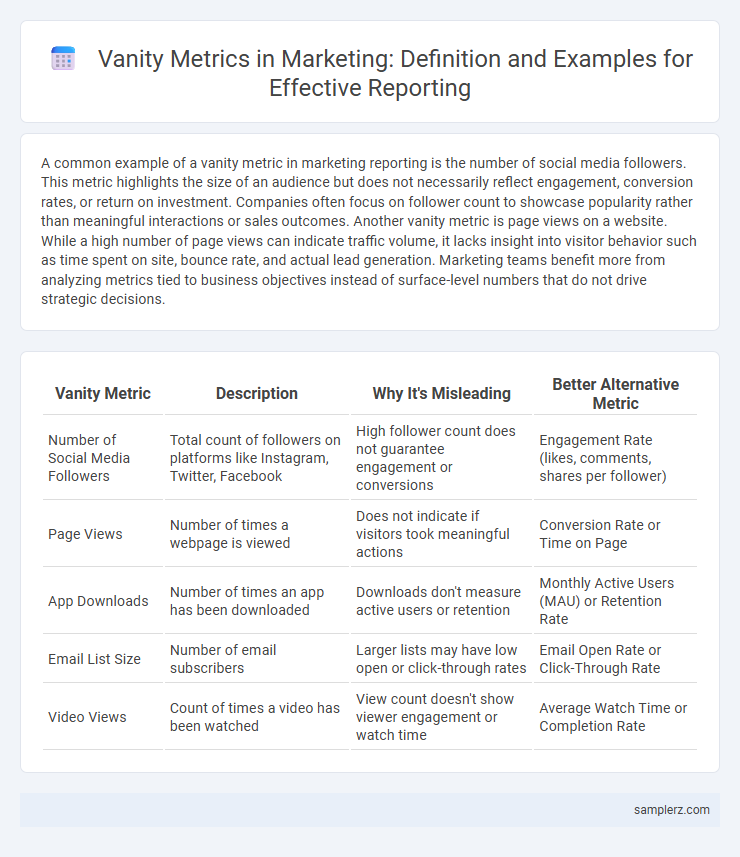A common example of a vanity metric in marketing reporting is the number of social media followers. This metric highlights the size of an audience but does not necessarily reflect engagement, conversion rates, or return on investment. Companies often focus on follower count to showcase popularity rather than meaningful interactions or sales outcomes. Another vanity metric is page views on a website. While a high number of page views can indicate traffic volume, it lacks insight into visitor behavior such as time spent on site, bounce rate, and actual lead generation. Marketing teams benefit more from analyzing metrics tied to business objectives instead of surface-level numbers that do not drive strategic decisions.
Table of Comparison
| Vanity Metric | Description | Why It's Misleading | Better Alternative Metric |
|---|---|---|---|
| Number of Social Media Followers | Total count of followers on platforms like Instagram, Twitter, Facebook | High follower count does not guarantee engagement or conversions | Engagement Rate (likes, comments, shares per follower) |
| Page Views | Number of times a webpage is viewed | Does not indicate if visitors took meaningful actions | Conversion Rate or Time on Page |
| App Downloads | Number of times an app has been downloaded | Downloads don't measure active users or retention | Monthly Active Users (MAU) or Retention Rate |
| Email List Size | Number of email subscribers | Larger lists may have low open or click-through rates | Email Open Rate or Click-Through Rate |
| Video Views | Count of times a video has been watched | View count doesn't show viewer engagement or watch time | Average Watch Time or Completion Rate |
Understanding Vanity Metrics in Marketing Reports
Vanity metrics in marketing reports, such as total page views or social media likes, often appear impressive but fail to provide actionable insights into campaign effectiveness or customer engagement. These metrics can inflate perceived success without correlating to key performance indicators like conversion rates or customer acquisition cost. Prioritizing meaningful data, such as click-through rates and lead quality, enables marketers to make informed decisions and optimize strategies for measurable growth.
Common Vanity Metrics Marketers Rely On
Common vanity metrics marketers rely on include social media follower counts, pageviews, and newsletter subscription numbers, which often fail to reflect genuine audience engagement or conversion success. These metrics can create an illusion of growth without correlating to increased sales, brand loyalty, or customer retention. Focusing on actionable KPIs such as conversion rates, customer lifetime value, and engagement quality provides more accurate insights into marketing effectiveness.
Social Media Followers: A Classic Vanity Metric
Measuring success by social media followers exemplifies a classic vanity metric, often misleading marketing performance. A high follower count does not necessarily translate into meaningful engagement, conversions, or brand loyalty, which are crucial for ROI. Effective reporting prioritizes metrics like engagement rate, click-through rate, and customer acquisition over superficial numbers such as follower quantity.
Page Views vs. Meaningful Engagement
Page views often serve as a vanity metric in marketing reports, highlighting quantity over quality by measuring surface-level website visits without indicating user intent or satisfaction. Meaningful engagement metrics, such as time on page, click-through rates, and conversion actions, provide deeper insights into audience behavior and the effectiveness of content strategies. Focusing on these engagement metrics enables marketers to optimize campaigns for genuine user interaction and business outcomes rather than merely inflating traffic numbers.
Impressions: The Illusion of Reach
Impressions often create the illusion of extensive reach in marketing reports, counting every instance an ad is displayed regardless of user engagement or quality. This vanity metric inflates perceived success but doesn't measure actual impact on conversions or customer behavior. Focusing solely on impressions risks misallocating budget away from more meaningful KPIs like click-through rates or conversion metrics.
Email Open Rates: What Do They Really Reveal?
Email open rates often serve as a vanity metric in marketing reporting because they indicate only how many recipients opened an email, not how engaged they were with the content or if they took any desired action. High open rates can be misleading, as they don't account for factors like image blocking or auto-loading previews that inflate open counts without genuine interest. Focusing on metrics such as click-through rates or conversion rates provides a more accurate measure of email campaign effectiveness and true audience engagement.
The Pitfall of Download Counts
Download counts often serve as a vanity metric in marketing reports, potentially misleading stakeholders by emphasizing quantity over quality. Focusing solely on the number of app downloads ignores critical engagement metrics such as user retention, active usage, and conversion rates. This pitfall can result in misguided strategies that fail to improve customer lifetime value or overall campaign effectiveness.
Tracking Video Views Without Context
Tracking video views without context is a common example of a vanity metric in marketing, as it measures quantity without revealing viewer engagement or conversion rates. High view counts may appear impressive but fail to indicate whether the content drives meaningful audience actions or brand awareness. Marketers should prioritize metrics like watch time, click-through rates, and conversion data to gain actionable insights beyond superficial view numbers.
Website Traffic vs. Conversion Metrics
High website traffic often serves as a vanity metric in marketing reports, giving the illusion of success without reflecting true business impact. Conversion metrics, such as lead generation rate or sales completed, provide a clearer indication of campaign effectiveness by measuring actual customer actions. Focusing on conversion rates rather than sheer visitor numbers enhances decision-making and optimizes marketing ROI.
Moving Beyond Vanity Metrics in Reporting
Click-through rates and social media likes often serve as vanity metrics in marketing reports, offering surface-level insights without reflecting true business impact. Moving beyond vanity metrics requires focusing on conversion rates, customer lifetime value, and return on investment to measure campaign effectiveness accurately. Data-driven analysis rooted in these meaningful KPIs enables marketers to optimize strategies for sustained growth and improved revenue.

example of vanity metric in reporting Infographic
 samplerz.com
samplerz.com